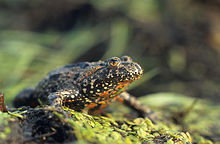European fire-bellied toad
This article includes a list of general references, but it remains largely unverified because it lacks sufficient corresponding inline citations. (May 2020) |
| European fire-bellied toad | |
|---|---|

| |
| Scientific classification | |
| Kingdom: | Animalia |
| Phylum: | Chordata |
| Class: | Amphibia |
| Order: | Anura |
| Family: | Bombinatoridae |
| Genus: | Bombina |
| Species: | B. bombina
|
| Binomial name | |
| Bombina bombina (Linnaeus, 1761)
| |

| |
| Synonyms | |
|
List
| |
The European fire-bellied toad (Bombina bombina) is a fire-bellied toad native to mainland Europe. Other common names used for the European fire-bellied toad include ringing frog, fiery toad, fire frog, and firebelly toad. It is a popular pet due to its bright colored belly.
Description[]
European fire-bellied toads have a bright lime green dorsal traversed by black spots, and orange to bright red bellies with black bars and stripes. The skin is mildly bumpy, the eyes set high to suit a semi-aquatic life style, and also well webbed back feet. Color and body variations will be described for each of the other 3 species commonly sold as or mistaken for Oriental fire-bellied toads. They are the largest of the bombina family. They are commonly darker than Fire-bellied toads from Asia.
The European fire-bellied toad is 26–60 mm long and may weigh 2-13.9 g. The body is depressed. Above, the skin is densely covered in low tubercles with black horny spines. There are no parotids behind the eyes but paired and arched gland complexes at the neck. The eardrums are not visible. Inner vocal sacs are present at the throat and webbings are well developed at the hind feet. The pupils are heart-shaped. The body colour is grey, brown or green with dark spots on the upper side and blackish with larger orange or red and smaller white spots on the underside. The skin produces a poison to protect itself from bacteria and fungi or the animal from vertebrates. This poison is irritating to mucous membranes. The eggs are brown above and lighter below. They are 1.4-1.8 mm large coated with a transparent jelly of 5–8 mm in diameter. Tadpoles may reach a length of 55 mm and are brownish above with two longitudinal pale bands along the backbone. The mouth field is triangular and the flipper is reticulated.
When they shed their skin, they bloat themselves and make a coughing sound, then start to tear the old skin off with their mouth, and eat it for nutrition, to reveal newer, brighter skin.
Diet[]
The food of the European fire-bellied toad consists of insects, spiders, millipedes, mollusks and earthworms captured in or nearby the water. The tadpoles mainly feed on algae, bacteria and plankton by grazing the surfaces of stones and plants. If attacked by a vertebrate on land the European fire-bellied toad makes a hollow-back and lifts its four legs so that the ventral warning colour is displayed. The combination of dark and red is a learned signal meaning “attention poison” to the enemy.
Reproduction[]
Reproduction takes place from April to July/August and is induced by heavy rainfall. Then, males can be recognized by some darkened, spiny swelling, the nuptial pad, on their forelegs. They help it to grasp the female properly around its hip. Males defend small territories of 2–3 m in diameter against rivals. Spawn consists of small clutches of 10–40 eggs which are attached to plants. Several such clutches are produced in a short time and thereby a female may lay a total of 80–300 eggs. Tadpoles hatch after 2–5 days and metamorphose after 5–12 weeks from July to September or after hibernation in spring. Young toads are 11–15 mm long and remain at the water's edge. Maturity is reached at an age of 1–2 years. The European fire-bellied toad may live more than 10 years. The rather loud melodic call is repeated about 10–50 times per minute, correlating with temperature, and is performed in the afternoon at temperatures of 12–34 °C while drifting at the water surface. The sound is produced when the air is pressed from the vocal sac back to the lungs which is the opposite to what “higher” frogs do. It hibernates on land in frost-resisting dens like hollows under stones or dead wood.
References[]
- ^ Aram Agasyan, Aziz Avisi, Boris Tuniyev, Jelka Crnobrnja Isailovic, Petros Lymberakis, Claes Andrén, Dan Cogalniceanu, John Wilkinson, Natalia Ananjeva, Nazan Üzüm, Nikolai Orlov, Richard Podloucky, Sako Tuniyev, Uğur Kaya (2009). "Bombina bombina". IUCN Red List of Threatened Species. 2009: e.T2865A9489517. doi:10.2305/IUCN.UK.2009.RLTS.T2865A9489517.en. Retrieved 11 November 2021.CS1 maint: multiple names: authors list (link)
- IUCN Red List least concern species
- Bombina
- Amphibians described in 1761
- Taxa named by Carl Linnaeus

